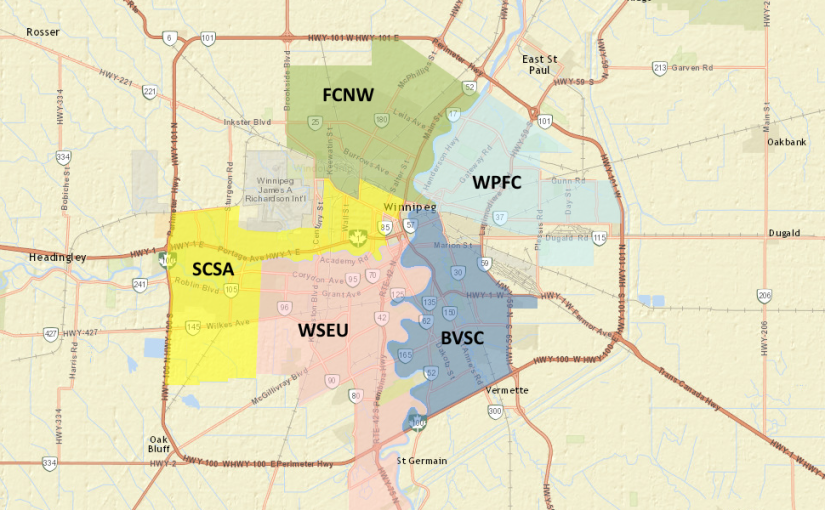Youth sports leagues are organized and managed in a variety of ways. Some tend to be more open and player centric while others are more regulated and club centric. The need for both exists depending on the leagues purpose and the clientele it serves. Geographical boundaries are but one form of regulation some youth sports league choose to impose. The premise is simple, a populous area, be it a town, city or region, served by the league is divided into districts or catchment areas from which its sporting clubs can draw upon for their player base. Seems fair enough if the league is a recreational sports league with the mandate to make sports fun and accessible to everyone. By forcing participants to register for a specific team based on their residence, it can offer benefits to both club and player. It ensures the survival of clubs with a guaranteed player base and it also ensures there is a program in place to serve the local general population. In theory this regulation seems a great benefit to all but very quickly situations that challenge its eminence can be identified, particularly when developmental or premier level of play is the league mandate.
Supply vs. Demand
Many youth sports leagues and/or their clubs cap the number of teams a club can enter in any given division or age group. Some clubs can easily max out their team allotment while others struggle simply to form a team. Sometimes player demand is greater than a clubs ability to supply them with teams or vice versa. Geographic boundaries don’t allow the “excess” players that didn’t make the cut at one club to join another club that may be struggling just to field a team. In a developmental or premier developmental league this is entirely counter productive to the league’s mandate to help players develop at a level beyond that of recreational play. Often players that want to train and develop get shut out from that experience due to rules prohibiting the crossing of boundaries. Such a system is in effect for Winnipeg’s only sanctioned youth soccer league. There are two clubs in particular that have operated efficiently and marketed themselves remarkably well to the point they have to cut a significant number of kids from most age groups every season, prohibiting them from playing developmental league soccer. Meanwhile, other city clubs struggle to form a single team and often having to depend on forms of age advancement to shuffle kids around simply to field teams in most age groups.
Degraded Competition
In premier/high performance leagues, clubs are often allowed to field a single premier team and sometimes one or more reserve or premier developmental teams. Great, few would dispute limiting a premier league to a single team of the top players each club has to offer. But, what if the castaways from one club who’s player supply far exceeds team limits are better players than those that struggling clubs are able to recruit? Under the restrictions of geographical boundaries, clubs that have difficulties recruiting players are sometimes forced to accept whoever can pay and wants to play, regardless of ability. Effectively creating a “pay to play” glorified rec league team. Such instances degrade the competition and are counter productive to the mandate of a “Premier” league.
Player Choice
Realistically, any player that chooses to play a sport at a developmental/primer level is generally committed to the sport and their personal growth within said sport. Whether these players have ambitions of playing at the highest youth levels, professionally, earn a college scholarship or become a coach, something beyond the recreational mentality of simply being active and having fun drives these players. They pay a premium financially and in the time they commit to learning their craft. Players and by extension their parents who pay the bills and invest significant time into their children’s sporting development ought to have a say in where and whom they wish to entrust with that development. Player satisfaction and development go hand in hand and can be tied to countless factors including club administration, technical staff experience and expertise, quality of training partners, club philosophy and ambition just to scratch the surface. If the player isn’t satisfied with some aspect of their club and doesn’t feel it is providing the development they were expecting or don’t feel they are receiving good value for their time and money why should they not be allowed to explore alternatives? We tend to think the grass will be greener on the other side only to find out it seldom is but for those who wish to explore, why stand in their way? In a society that prides itself on freedom of choice it’s a shame we offer our children so little in their sporting development.
What Would Open Boundaries Mean?
It’s widely believed clubs that oppose open boundaries are afraid their programs will suffer, perhaps even collapse. That’s rubbish! Under open boundaries there would indeed be a lot of player movement in and out of all clubs before settling down. Ultimately I think we would see a significant rise in the participation rate as the program becomes more accessible, this would result in club and subsequently league growth. Players once neglected by the harsh supply/demand reality of geographical boundaries would finally have the option of playing elsewhere and getting the developmental opportunities they seek and deserve. The primary benefactors of this would be the clubs struggling to field teams.
The Winners and the Losers
Under the restrictions of geographical boundaries everyone involved in competitive youth sports loses! The leagues, its clubs and all the players end up suffering in one form or another. Under open boundaries everyone from individual players right up national programs can benefit. Leagues and their clubs benefit financially from increased participation, players are given greater control and decision making in their development and this all leads to a larger, better trained player population which can benefit provincial and national programs.


